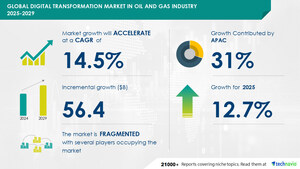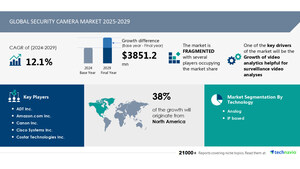NEW YORK, Oct. 14, 2024 /PRNewswire/ -- Report with the AI impact on market trends- The global hyperspectral imaging market size is estimated to grow by USD 792.1 millionn from 2024-2028, according to Technavio. The market is estimated to grow at a CAGR of 12.1% during the forecast period. Increasing use of night vision cameras is driving market growth, with a trend towards growing number of research projects using hyperspectral imaging techniques. However, high capital investment poses a challenge. Key market players include Applied Spectral Imaging, BaySpec Inc., Brandywine Photonics, Corning Inc., Cubert GmbH, Galileo Group Inc., Gamaya, Headwall Photonics Inc., HyperMed Imaging Inc., HyVista Corp. Pty Ltd., IMEC Inc., inno-spec GmbH, Konica Minolta Inc., Norsk Elektro Optikk AS, Polytec GmbH, Resonon Inc., Surface Optics Corp., Telops Inc., TruTag Technologies Inc., and XIMEA GmbH.
AI-Powered Market Evolution Insights. Our comprehensive market report ready with the latest trends, growth opportunities, and strategic analysis- View your snapshot now
Forecast period |
2024-2028 |
Base Year |
2023 |
Historic Data |
2018 - 2022 |
Segment Covered |
Application (Military and surveillance, Healthcare, Food and agriculture, Remote sensing, and Others), Product (Cameras and Accessories), and Geography (North America, Europe, APAC, South America, and Middle East and Africa) |
Region Covered |
North America, Europe, APAC, South America, and Middle East and Africa |
Key companies profiled |
Applied Spectral Imaging, BaySpec Inc., Brandywine Photonics, Corning Inc., Cubert GmbH, Galileo Group Inc., Gamaya, Headwall Photonics Inc., HyperMed Imaging Inc., HyVista Corp. Pty Ltd., IMEC Inc., inno-spec GmbH, Konica Minolta Inc., Norsk Elektro Optikk AS, Polytec GmbH, Resonon Inc., Surface Optics Corp., Telops Inc., TruTag Technologies Inc., and XIMEA GmbH |
Key Market Trends Fueling Growth
Hyperspectral imaging is a valuable technology used in various research fields, including vegetation analysis, food testing, mineral exploration, and forensics. Hyperspectral scanners can identify and measure the physical, chemical, and biological properties of objects and organisms. The Indian Space Research Organization (ISRO) launched the first Indian Hyperspectral Imaging Satellite (HySIS) in November 2018, which is used for earth observation applications in agriculture, forestry, geology, coastal zones, and environmental studies. Hyperspectral imaging captures images across 48 color channels, providing multiple values for each pixel, ensuring precise data for distinguishing between fluorophores and cells. Additionally, universities collaborate with companies to research advanced hyperspectral imaging devices using modern technology, ensuring ongoing projects and market growth during the forecast period.
The Hyperspectral Imaging (HSI) market is experiencing significant growth due to its applications in various industries. Key trends include the use of satellites for remote sensing and secondary illumination for improved sensitivity. Sensor noise reduction and spectral resolution enhancement are crucial for accurate spectral data acquisition. In the healthcare sector, HSI is being explored for skin cancer diagnosis, with potential for AI capabilities and super-resolution. Aerospace, defense, and agriculture are major industries leveraging HSI for spatial and temporal data. Standardization and accessorization are important for market expansion. Start-ups bring innovation with advanced technologies, while territorial fights and atmospheric scattering pose challenges. The three-dimensional data cube and video rate capabilities offer new opportunities. The visible spectrum and spectral range are essential for various applications, from diabetic diagnosis to diagnostic imaging, and differencing capability enhances data analysis. Specialized components and spectral information are vital for HSI cameras and sensors.
Insights on how AI is driving innovation, efficiency, and market growth- Request Sample!
Market Challenges
- The hyperspectral imaging market faces significant challenges due to the high capital investment required for advanced technology and equipment. This includes the production of specialized low-light-level imaging sensors and capital equipment. To meet consumer demands, foundries must expand their production capacity and invest in research and development. However, some vendors lack the financial resources for such investments, making it a risky proposition with potential long-term profitability. This may put smaller vendors at a disadvantage compared to industry leaders, who can afford to innovate and launch new products during the forecast period.
- Hyperspectral Imaging (HSI) is a modern imaging technology that captures full spectrum information at high resolution, offering enhanced safety and precision in various industries. However, the market faces challenges in digital transformation and interoperability with existing digital imaging systems. HSI is making strides in healthcare for early disease detection in medical fields such as Glaucoma and retinal inspection. In food industry, it ensures product quality by detecting harmful algae blooms and food contaminants. HSI is also vital in homeland security, military surveillance, and mining for persistent surveillance and material identification. In research projects, HSI aids in the identification of rock minerals and plant diseases. Companies like Headwall Photonics provide HSI solutions with F-mount lenses and analytical procedures. Despite regulations, HSI is replacing multispectral imaging in various applications, including optical sorting and RGB imaging. Machine learning and machine vision are enhancing HSI capabilities, making it a valuable tool for remote sensing and night vision in diverse industries.
Insights into how AI is reshaping industries and driving growth- Download a Sample Report
Segment Overview
This hyperspectral imaging market report extensively covers market segmentation by
- Application
- 1.1 Military and surveillance
- 1.2 Healthcare
- 1.3 Food and agriculture
- 1.4 Remote sensing
- 1.5 Others
- Product
- 2.1 Cameras
- 2.2 Accessories
- Geography
- 3.1 North America
- 3.2 Europe
- 3.3 APAC
- 3.4 South America
- 3.5 Middle East and Africa
1.1 Military and surveillance- Hyperspectral imaging sensors are gaining popularity in the unmanned vehicles market due to their small size and strong optical performance. The increasing use of unmanned aerial vehicles (UAVs) and unmanned ground vehicles (UGVs) in tactical missions by military forces is driving the growth of the global hyperspectral imaging market. These sensors are loaded with spectral signatures, making them powerful tools for base protection, security, and intelligence, surveillance, and reconnaissance (ISR) missions. Military authorities worldwide invest in ISR to gather intelligence from potential enemies and advance national security. Hyperspectral imaging sensors can detect materials and objects, such as disturbed earth or hidden ponds, that cannot be identified using other techniques. The military surveillance segment is a significant contributor to the global hyperspectral imaging market due to the use of hyperspectral sensors for countermeasures against airborne surveillance. The growth in military and surveillance applications will continue to fuel the market's expansion during the forecast period.
Download complimentary Sample Report to gain insights into AI's impact on market dynamics, emerging trends, and future opportunities- including forecast (2024-2028) and historic data (2018 - 2022)
Research Analysis
Hyperspectral imaging is a modern technology that goes beyond traditional multispectral imaging by providing detailed spectral information in the near-infrared ranges. This technology creates a three-dimensional data cube, allowing for a more comprehensive analysis of materials and substances. Hyperspectral imaging is increasingly used in various industries, including agriculture for crop health monitoring, defense for target recognition, research projects for scientific discovery, and healthcare for disease diagnosis. The market for hyperspectral imaging is growing due to its enhanced safety and remote sensing capabilities. Start-ups and key players are investing heavily in this technology, leading to territorial fights for market share. Data storage and processing are becoming critical challenges as the amount of spectral data generated continues to increase. The spectral range and resolution of hyperspectral imaging systems are continually improving, enabling new applications in night vision and other fields.
Market Research Overview
Hyperspectral Imaging (HSI) is a advanced imaging technology that captures and processes spectral data in the visible and near-infrared ranges. This technology offers enhanced safety, precision, and degree of innovation in various industries. In Aerospace, HSI is used for persistent surveillance, ocean color analysis, and military surveillance. In Agriculture, it aids in early disease detection, crop health monitoring, and soil analysis. In Healthcare, HSI is utilized for medical applications such as diabetes diagnosis, skin cancer detection, and retinal inspection. In Defense and Homeland Security, it is used for material and substance identification, threat detection, and border control. HSI also finds applications in Mining for mineral identification, Optical sorting, and raw materials analysis. With the integration of AI capabilities, machine learning, and digital transformation, HSI is evolving into a modern technology with interoperability and standardization. The ecosystem includes various accessories and cameras, such as F-mount lenses and high-resolution imagery cameras, and specialized components. The market is witnessing an influx of start-ups and research projects, leading to product substitutes and analytical procedures. However, regulations and sensor noise are challenges that need to be addressed. HSI is also used in various medical fields, including glaucoma and diabetic retinopathy diagnosis, and in military surveillance for harmful algae blooms and night vision. The technology's ability to provide full spectrum, high-resolution, and three-dimensional data cubes makes it a valuable tool for various applications.
Table of Contents:
1 Executive Summary
2 Market Landscape
3 Market Sizing
4 Historic Market Size
5 Five Forces Analysis
6 Market Segmentation
- Application
- Military And Surveillance
- Healthcare
- Food And Agriculture
- Remote Sensing
- Others
- Product
- Cameras
- Accessories
- Geography
- North America
- Europe
- APAC
- South America
- Middle East And Africa
7 Customer Landscape
8 Geographic Landscape
9 Drivers, Challenges, and Trends
10 Company Landscape
11 Company Analysis
12 Appendix
About Technavio
Technavio is a leading global technology research and advisory company. Their research and analysis focuses on emerging market trends and provides actionable insights to help businesses identify market opportunities and develop effective strategies to optimize their market positions.
With over 500 specialized analysts, Technavio's report library consists of more than 17,000 reports and counting, covering 800 technologies, spanning across 50 countries. Their client base consists of enterprises of all sizes, including more than 100 Fortune 500 companies. This growing client base relies on Technavio's comprehensive coverage, extensive research, and actionable market insights to identify opportunities in existing and potential markets and assess their competitive positions within changing market scenarios.
Contacts
Technavio Research
Jesse Maida
Media & Marketing Executive
US: +1 844 364 1100
UK: +44 203 893 3200
Email: [email protected]
Website: www.technavio.com/
SOURCE Technavio

WANT YOUR COMPANY'S NEWS FEATURED ON PRNEWSWIRE.COM?
Newsrooms &
Influencers
Digital Media
Outlets
Journalists
Opted In



Share this article